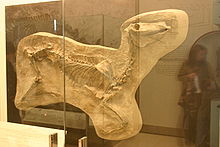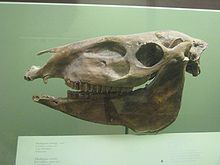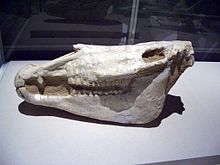- Evolution of the horse
-
 This image shows a representative sequence but should not be construed to represent a "straight-line" evolution of the horse. Reconstruction, left forefoot skeleton (third digit emphasized yellow) and longitudinal section of molars of selected prehistoric horses
This image shows a representative sequence but should not be construed to represent a "straight-line" evolution of the horse. Reconstruction, left forefoot skeleton (third digit emphasized yellow) and longitudinal section of molars of selected prehistoric horses
The evolution of the horse pertains to the phylogenetic ancestry of the modern horse from the small dog-sized[1], forest-dwelling Hyracotherium over geologic time scales. Paleozoologists have been able to piece together a more complete picture of the modern horse's evolutionary lineage than that of any other animal.
The horse belongs to an order known as Perissodactyla, or "odd-toed ungulates", which all share hoofed feet and an odd number of toes on each foot, as well as mobile upper lips and a similar tooth structure. This means that horses share a common ancestry with tapirs and rhinoceroses. The perissodactyls originally arose in the late Paleocene, less than 10 million years after the Cretaceous-Tertiary extinction event. This group of animals appears to have been originally specialized for life in tropical forests, but whereas tapirs and, to some extent, rhinoceroses, retained their jungle specializations, modern horses are adapted to life on drier land in the much-harsher climatic conditions of the steppes. Other species of Equus are adapted to a variety of intermediate conditions.
The early ancestors of the modern horse walked on several spread-out toes, an accommodation to life spent walking on the soft, moist grounds of primeval forests. As grass species began to appear and flourish, the equids' diets shifted from foliage to grasses, leading to larger and more durable teeth. At the same time, as the steppes began to appear, the horse's predecessors needed to be capable of greater speeds to outrun predators. This was attained through the lengthening of limbs and the lifting of some toes from the ground in such a way that the weight of the body was gradually placed on one of the longest toes, the third.
Contents
History of research
 Restoration of Eurohippus parvulus, Museum für Naturkunde, Berlin
Restoration of Eurohippus parvulus, Museum für Naturkunde, Berlin
Indigenous modern horses died out in the New World at the end of the Pleistocene, about 12 000 years ago, and thus were absent until the Spanish brought domestic horses from Europe, beginning in 1493. Escaped horses quickly established large wild herds. The early naturalist Buffon suggested in the 1760s that this was an indication of inferiority of fauna in the New World, then later reconsidered this idea.[2] William Clark's 1807 expedition to Big Bone Lick found "leg and foot bones of the Horses" which were included with other fossils sent to Thomas Jefferson and evaluated by the anatomist Caspar Wistar, but neither commented on the significance of this find.[3]
The first equid fossil was found in the gypsum quarries in Montmartre, Paris in the 1820s. The tooth was sent to the Paris Conservatory, where it was identified by Georges Cuvier who identified it as a browsing equine related to the tapir.[4] His sketch of the entire animal matched later skeletons found at the site.[5]
During the Beagle survey expedition the young naturalist Charles Darwin had remarkable success with fossil hunting in Patagonia. On 10 October 1833 at Santa Fe, Argentina, he was "filled with astonishment" when he found a horse's tooth in the same stratum as fossil giant armadillos, and wondered if it might have been washed down from a later layer, but concluded that this was "not very probable".[6] After the expedition returned in 1836, the anatomist Richard Owen confirmed the tooth was from an extinct species which he subsequently named Equus curvidens, and remarked that "This evidence of the former existence of a genus, which, as regards South America, had become extinct, and has a second time been introduced into that Continent, is not one of the least interesting fruits of Mr. Darwin's palæontological discoveries."[3][7]
In 1848 a study On the fossil horses of America by Joseph Leidy systematically examined Pleistocene horse fossils from various collections, including that of the Academy of Natural Sciences and concluded at least two ancient horse species had existed in North America: Equus curvidens and another which he named Equus americanus. A decade later, however, he found the latter name had already been taken and renamed it Equus complicatus.[2] In the same year, he visited Europe and was introduced by Owen to Darwin.[8]
The original sequence of species believed to have evolved into the horse was based on fossils discovered in North America in the 1870s by paleontologist Othniel Charles Marsh. The sequence, from Hyracotherium (popularly called Eohippus) to the modern horse (Equus), was popularized by Thomas Huxley and became one of the most widely-known examples of a clear evolutionary progression. The horse's evolutionary lineage became a common feature of biology textbooks, and the sequence of transitional fossils was assembled by the American Museum of Natural History into an exhibit which emphasized the gradual, "straight-line" evolution of the horse.
Since then, as the number of equid fossils has increased, the actual evolutionary progression from Hyracotherium to Equus has been discovered to be much more complex and multi-branched than was initially supposed. The straight, direct progression from the former to the latter has been replaced by a more elaborate model with numerous branches in different directions, of which the modern horse is only one of many. It was first recognized by George Gaylord Simpson in 1951[9] that the modern horse was not the "goal" of the entire lineage of equids,[10] it is simply the only genus of the many horse lineages that has survived.
Detailed fossil information on the rate and distribution of new equid species has also revealed the progression between species was not as smooth and consistent as was once believed. Although some transitions, such as that of Dinohippus to Equus, were indeed gradual progressions, a number of others, such as that of Epihippus to Mesohippus, were relatively abrupt and sudden in geologic time, taking place over only a few million years. Both anagenesis (gradual change in an entire population's gene frequency) and cladogenesis (a population "splitting" into two distinct evolutionary branches) occurred, and many species coexisted with "ancestor" species at various times. The change in equids' traits was also not always a "straight line" from Hyracotherium to Equus: some traits reversed themselves at various points in the evolution of new equid species, such as size and the presence of facial fossae, and it is only in retrospect that certain evolutionary trends can be recognized.[11]
Eocene and Oligocene: early equids
Hyracotherium
The earliest animal to bear recognizably horse-like anatomy was the Hyracotherium ("hyrax-like beast"). Its scientific name is derived from initial confusion over early partial fossils' relationship with living species: Richard Owen likened early Hyracotherium fossils "to a hare in one passage and to something between a hog and a hyrax in another".[12] A later name for the Hyracotherium, "eohippus" ("dawn horse"), is also popular, though the earlier name takes precedence due to scientific naming conventions.[13][14]
Hyracotherium lived in the Ypresian (early Eocene), about 52 mya (million years ago). It was an animal approximately the size of a fox (250–450 mm in height), with a relatively short head and neck and a springy, arched back. It had 44 low-crowned teeth, in the typical arrangement of an omnivorous, browsing mammal: 3 incisors, 1 canine, 4 premolars, and 3 molars on each side of the jaw. Its molars were uneven, dull, and bumpy, and used primarily for grinding foliage. The cusps of the molars were slightly connected in low crests. The Hyracotherium browsed on soft foliage and fruit, probably scampering between thickets in the mode of a modern muntjac; the Hyracotherium had a small brain, and possessed especially small frontal lobes.[11]
 Hyracotherium, with left forefoot (third metacarpal colored) and tooth (a enamel; b dentin; c cement) detailed.
Hyracotherium, with left forefoot (third metacarpal colored) and tooth (a enamel; b dentin; c cement) detailed.
Its limbs were decently long relative to its body, already showing the beginnings of adaptations for running. However, all of the major leg bones were unfused, leaving the legs flexible and rotatable. Its wrist and hock joints were low to the ground. The forelimbs had developed five toes, out of which only four were equipped with a small proto-hoof; the large fifth "toe-thumb" was off the ground. The hind limbs had three out of the five toes equipped with small hooves, while the vestigial first and fifth toes did not touch the ground. Its feet were padded, much like a dog's, but with the small hooves on each toe in place of claws.
For a span of about 20 million years, the Hyracotherium thrived with few significant evolutionary changes.[11] The most significant change was in the teeth, which began to adapt to the changing diet of Hyracotheria, as these early Equidae shifted from a mixed diet of fruits and foliage to one focused increasingly on browsing foods. During the Eocene, a Hyracotherium species (most likely Hyracotherium vassacciense) branched out into various new types of Equidae. Thousands of complete, fossilized skeletons of these animals have been found in the Eocene layers of North American strata, mainly in the Wind River basin in Wyoming. Similar fossils have also been discovered in Europe, such as Propalaeotherium (which is not considered ancestral to the modern horse).[15]
Orohippus
Approximately 50 million years ago, in the early-to-middle Eocene, Hyracotherium smoothly transitioned into Orohippus over a gradual series of changes.[15] Although its name means "mountain horse", Orohippus was not a true horse and did not live in the mountains. It resembled Hyracotherium in size, but had a slimmer body, an elongated head, slimmer forelimbs, and longer hind legs, all of which are characteristics of a good jumper. Although Orohippus was still pad-footed, the vestigial outer toes of Hyracotherium were not present in the Orohippus; there were four toes on each forelimb, and three on each hind leg.
The most dramatic change between Hyracotherium and Orohippus was in the teeth: the first of the premolar teeth were dwarfed, the last premolar shifted in shape and function into a molar, and the crests on the teeth became more pronounced. Both of these factors gave the teeth of Orohippus greater grinding ability, suggesting that Orohippus ate tougher plant material.
Epihippus
In the mid-Eocene, about 47 million years ago, Epihippus, a genus which continued the evolutionary trend of increasingly efficient grinding teeth, evolved from Orohippus. Epihippus had five grinding, low-crowned cheek teeth with well-formed crests. A late species of Epihippus, sometimes referred to as Duchesnehippus intermedius, had teeth similar to Oligocene equids, although slightly less developed. Whether Duchesnehippus was a subgenus of Epihippus or a distinct genus is disputed.
Mesohippus
In the late Eocene and the early stages of the Oligocene epoch (32–24 mya), the climate of North America became drier, and the earliest grasses began to evolve. The forests were yielding to flatlands,[citation needed] home to grasses and various kinds of brush. In a few areas these plains were covered in sand,[citation needed] creating the type of environment resembling the present-day prairies.
In response to the changing environment, the then-living species of Equidae also began to change. In the late Eocene, they began developing tougher teeth and becoming slightly larger and leggier, allowing for faster running speeds in open areas, and thus for evading predators in non-wooded areas[citation needed]. About 40 mya, Mesohippus ("middle horse") suddenly developed in response to strong new selective pressures to adapt, beginning with the species Mesohippus celer and soon followed by Mesohippus westoni.
In the early Oligocene, Mesohippus was one of the more widespread mammals in North America. It walked on three toes on each of its front and hind feet (the first and fifth toes remained, but were small and not used in walking). The third toe was stronger than the outer ones, and thus more weighted; the fourth front toe was diminished to a vestigial nub. Judging by its longer and slimmer limbs, Mesohippus was an agile animal.
Mesohippus was slightly larger than Epihippus, about 610 mm (24") at the shoulder. Its back was less arched, and its face, snout, and neck were somewhat longer. It had significantly larger cerebral hemispheres, and had a small, shallow depression on its skull called a fossa, which in modern horses is quite detailed. The fossa serves as a useful marker for identifying an equine fossil's species. Mesohippus had six grinding "cheek teeth", with a single premolar in front—a trait all descendant Equidae would retain. Mesohippus also had the sharp tooth crests of Epihippus, improving its ability to grind down tough vegetation.
Miohippus
Around 36 million years ago, soon after the development of Mesohippus, Miohippus ("lesser horse") emerged, the earliest species being Miohippus assiniboiensis. Like Mesohippus, Miohippus's evolution was relatively abrupt, though a few transitional fossils linking the two genera have been found. It was once believed that Mesohippus had anagenetically evolved into Miohippus by a gradual series of progressions, but new evidence has shown that Miohippus's evolution was cladogenetic: a Miohippus population split off from the main Mesohippus genus, coexisted with Mesohippus for around 4 million years, and then over time came to replace Mesohippus.[16]
Miohippus was significantly larger than its predecessors, and its ankle joints had subtly changed. Its facial fossa was larger and deeper, and it also began to show a variable extra crest in its upper cheek teeth, a trait that became a characteristic feature of equine teeth.
Miohippus ushered in a major new period of diversification in Equidae.[14] While Mesohippus died out in the mid-Oligocene, Miohippus continued to thrive, and in the early Miocene (24–5.3 mya), it began to rapidly diversify and speciate. It branched out into two major groups, one of which adjusted to the life in forests once again, while the other remained suited to life on the prairies.[citation needed]
Miocene and Pliocene: true equines
Kalobatippus
 Fossil Megahippus mckennai
Fossil Megahippus mckennai
The forest-suited form was Kalobatippus (or Miohippus intermedius, depending on whether it was a new genus or species), whose second and fourth front toes were long, well-suited travel on the soft forest floors. Kalobatippus probably gave rise to Anchitherium, which travelled to Asia via the Bering Strait land bridge, and from there to Europe.[17] In both North America and Eurasia, larger-bodied genera evolved from Anchitherium; Sinohippus in Eurasia and Hypohippus and Megahippus in North America.[18] Hypohippus became extinct by the late Miocene.[19]
Parahippus
The Miohippus population that remained on the steppes is believed to be ancestral to Parahippus, a North American animal about the size of a small pony, with a prolonged skull and a facial structure resembling the horses of today. Its third toe was stronger and larger, and carried the main weight of the body. Its four premolars resembled the molar teeth and the first were small and almost nonexistent. The incisive teeth of Parahippus, like those of its predecessors, had a crown as humans do; however, the top incisors had a trace of a shallow crease marking the beginning of the core/cup.
Merychippus
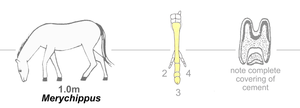 Merychippus, an effective grazer and runner.
Merychippus, an effective grazer and runner.
In the middle of the Miocene epoch, the grazer Merychippus flourished. Merychippus had wider molars than its predecessors, which are believed to have been used for crunching the hard grasses of the steppes. The hind legs, which were relatively short, had side toes equipped with small hooves, but they probably only touched the ground when running.[14] Merychippus radiated into at least 19 additional grassland species.
Hipparion
Three lineages within Equidae are believed to be descended from the numerous varieties of Merychippus: Hipparion, Protohippus and Pliohippus. The most different from Merychippus was Hipparion. The main difference was in the structure of tooth enamel: in comparison with other Equidae, the inside, or tongue side, had a completely isolated parapet. A complete and well-preserved skeleton of the North American Hipparion shows an animal the size of a small pony. They were very slim, rather like antelopes, and were adapted to life on dry prairies. On its slim legs, Hipparion had three toes equipped with small hooves, but the side toes did not touch the ground.
In North America, Hipparion and its relatives (Cormohipparion, Nannippus, Neohipparion, and Pseudhipparion), proliferated into many kinds of equids, at least one of which managed to migrate to Asia and Europe during the Miocene epoch.[20] (European Hipparion differs from American Hipparion in its smaller body size – the best-known discovery of these fossils was near Athens.)
Pliohippus
Pliohippus arose from Callippus in the middle Miocene, around 12 mya. It was very similar in appearance to Equus, though it had two long extra toes on both sides of the hoof, externally barely visible as callused stubs. The long and slim limbs of Pliohippus reveal a quick-footed steppe animal.
Until recently, Pliohippus was believed to be the ancestor of present-day horses because of its many anatomical similarities. However, though Pliohippus was clearly a close relative of Equus, its skull had deep facial fossae, whereas Equus had no fossae at all. Additionally, its teeth were strongly curved, unlike the very straight teeth of modern horses. Consequently, it is unlikely to be the ancestor of the modern horse; instead, it is a likely candidate for the ancestor of Astrohippus.[21]
Dinohippus
Dinohippus was the most common species of Equidae in North America during the late Pliocene. It was originally thought that Dinohippus was monodactyl, but a 1981 fossil find in Nebraska shows that some were tridactyl.
Plesippus
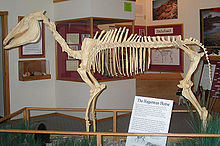 Mounted skeleton of Hagerman Horse (Equus simplicidens)
Mounted skeleton of Hagerman Horse (Equus simplicidens)
Plesippus is often considered an intermediate stage between Dinohippus and the extant genus, Equus.
The famous fossils found near Hagerman, Idaho were originally thought to be a part of the genus Plesippus. Hagerman Fossil Beds (Idaho) is a Pliocene site, dating to about 3.5 mya. The fossilized remains were originally called Plesippus shoshonensis, but further study by paleontologists determined that fossils represented the oldest remains of the genus Equus.[22] Their estimated average weight was 425 kg, roughly the size of an Arabian horse.
At the end of the Pliocene, the climate in North America began to cool significantly and most of the animals were forced to move south. One population of Plesippus moved across the Bering land bridge into Eurasia around 2.5 Mya.[23]
Modern horses
Equus
The genus Equus, which includes all extant equines, is believed to have evolved from Dinohippus, via the intermediate form Plesippus. One of the oldest species is Equus simplicidens, described as zebra-like with a donkey-shaped head. The oldest material to date is ~3.5 million years old from Idaho, USA. The genus appears to have spread quickly into the Old World, with the similarly aged Equus livenzovensis documented from western Europe and Russia.[24]
Molecular phylogenies indicate that the most recent common ancestor of all modern equids (members of the genus Equus) lived ~5.6 (3.9-7.8) mya. The oldest divergencies are the Asian hemiones (subgenus E. (Asinus)), including the Kulan, Onager, and Kiang), followed by the African zebras (subgenera E. (Dolichohippus), and E. (Hippotigris)). All other modern forms including the domesticated horse (and many fossil Pliocene and Pleistocene forms) belong to the subgenus E. (Equus) which diverged ~4.8 (3.2-6.5) million years ago.[25]
Pleistocene horse fossils have been assigned to a multitude of species, with over 50 species of equines described from the Pleistocene of North America alone, although the taxonomic validity of most of these has been called into question.[26] Recent genetic work on fossils has found evidence for only three genetically divergent equid lineages in Pleistocene North and South America.[25] These results suggest that all North American fossils of caballine-type horses (which also include the domesticated horse and Przewalski's Horse of Europe and Asia), as well as South American fossils traditionally placed in the subgenus E. (Amerhippus)[27] belong to the same species: E. ferus. Remains attributed to a variety of species and lumped as New World stilt-legged horses (including E. francisci, E. tau, E. quinni and potentially N. American Pleistocene fossils previously attributed to E. cf. hemiones, and E. (Asinus) cf. kiang) likely all belong to a second species endemic to N. America, which despite a superficial resemblance to species in the subgenus E. (Asinus) (and hence occasionally referred to as North American Ass) is closely related to E. ferus.[25] Surprisingly, the third species, endemic to S. America, and traditionally referred to as Hippidion, originally believed to be descended from Pliohippus, was shown to be a third species in the genus Equus, closely related to the New World stilt-legged horse.[25] The temporal and regional variation in body size and morphological features within each lineage indicates extraordinary intraspecific plasticity. Such environment-driven adaptative changes would explain why the taxonomic diversity of Pleistocene equids has been overestimated on morphoanatomical grounds.[27]
According to these results, it appears that the genus Equus evolved from a Dinohippus-like ancestor ~4-7 mya. It rapidly spread into the Old World and there diversified into the various species of asses and zebras. A North American lineage of the subgenus E. (Equus) evolved into the New World stilt-legged horse (NWSLH). Subsequently, populations of this species entered South America as part of the Great American Interchange shortly after the formation of the Isthmus of Panama and evolved into the form currently referred to as "Hippidion" ~2.5 million years ago. "Hippidion" is thus unrelated to the morphologically similar Pliohippus, which presumably went extinct during the Miocene. Both the NWSLH and "Hippidium" show adaptations to dry, barren ground, whereas the shortened legs of "Hippidion" may have been a response to sloped terrain.[27] In contrast, the geographic origin of the closely related modern E. ferus is not resolved. However, genetic results on extant and fossil material of Pleistocene age indicate two clades, potentially subspecies, one of which had a holarctic distribution spanning from Europe through Asia and across North America and would become the founding stock of the modern domesticated horse.[28][29] The other population appears to have been restricted to N. America. One or more N. American populations of E. ferus entered S. America ~1.0-1.5 million years ago, leading to the forms currently known as "E. (Amerhippus)", which represent an extinct geographic variant or race of E. ferus, however.
Pleistocene extinctions
Digs in western Canada have unearthed clear evidence that horses existed in North America until about 12,000 years ago.[30] However, all Equidae in North America ultimately became extinct. The causes of this extinction (simultaneous with the extinctions of a variety of other American megafauna) have been a matter of debate. Given the suddenness of the event and the fact that these mammals had been flourishing for millions of years previously, something quite unusual must have happened. There are two main hypotheses. The first attributes extinction to climate change. For example, in Alaska, beginning approximately 12,500 years ago, the grasses characteristic of a steppe ecosystem gave way to shrub tundra, which was covered with unpalatable plants.[31][32] Another hypothesis suggests extinction was linked to overexploitation of naive prey by newly arrived humans. Extinctions were roughly simultaneous with the end of the most recent glacial advance and the appearance of the big-game-hunting Clovis culture.[33][34] Several studies have indicated that humans probably arrived in Alaska at the same time or shortly before the local extinction of horses.[34][35][36] Additionally, it has been proposed that the steppe-tundra vegetation transition in Beringia may have been a consequence, rather than a cause, of the extinction of megafaunal grazers.[37]
In Eurasia, horse fossils began occurring frequently again in archaeological sites in Kazakhstan and the southern Ukraine about 6,000 years ago.[28] From then on, it is probable that domesticated horses as well as the knowledge of capturing, taming, and rearing horses spread relatively quickly, with wild mares from several wild populations being incorporated en route.[29]
Return to the Americas
Horses only returned to the Americas with Christopher Columbus in 1493. These were Iberian horses first brought to Hispaniola and later to Panama, Mexico, Brazil, Peru, Argentina, and, in 1538, Florida.[38] The first horses to return to the main continent were 16 specifically identified horses brought by Hernan Cortes. Subsequent explorers, such as Coronado and De Soto brought ever-larger numbers, some from Spain and other from breeding establishments set up by the Spanish in the Caribbean. Later, as Spanish missions were founded on the mainland, horses would eventually be lost or stolen, and proliferated into large herds of feral horses that became known as mustangs.[citation needed]
The indigenous peoples of the Americas did not have a specific word for horses, and came to refer to them in various languages as a type of dog or deer (in one case, "elk-dog").[citation needed]
Details
Toes
The ancestors of the horse came to walk only on the end of the third toe and both side toes. Skeletal remnants show obvious wear on the back of both sides of metacarpal and metatarsal bones, commonly called the “splint bones”. They are the remnants of the second and the fourth toe. Modern horses retain the splint bones; it is often believed that they are a useless attachment, but they in fact play an important role in supporting the carpal joints (front knee) and even the tarsal joints (hock).
Teeth
Throughout the phylogenetic development, the teeth of the horse underwent significant changes. The type of the original omnivorous teeth with short, "bumpy" molars, with which the prime members of the evolutionary line distinguished themselves, gradually changed into the teeth common to herbivorous mammals. They became long (as much as 100 mm), roughly cubical molars equipped with a flat grinding surface. In conjunction with the teeth, during the horse’s evolution the elongation of the facial part of the skull is apparent, and can also be observed in the backward set eyeholes. In addition, the relatively short neck of the equine ancestors became longer with equal elongation of the legs. Finally, the size of the body grew as well.
See also
Further reading
- MacFadden, Bruce J (2003 digitization of 1999 reprint). Fossil Horses: Systematics, Paleobiology, and Evolution of the Family Equidae. Cambridge & New York: Cambridge University Press. ISBN 0-521-47708-5. http://books.google.com/?id=K1upTamSEW0C&printsec=frontcover&dq=%22fossil+horses%22&cd=1#v=onepage&q. Retrieved 6 June 2010
References
- ^ Legendre, Serge (1989). Les communautés de mammifères du Paléogène (Eocène supérieur et Oligocène) d'Europe occidentale : structures, milieux et évolution. München: F. Pfeil. pp. 110. ISBN 9783923871353.
- ^ a b Academy of Natural Sciences - Joseph Leidy - American Horses
- ^ a b Academy of Natural Sciences - Thomas Jefferson Fossil Collection - Ancient Horse Fossils
- ^ Horse breeding and management, James Warren Evans 1992
- ^ Knell, Simon J.; Suzanne Macleod; Sheila E. R. Watson; Museum revolutions: how museums and change and are changed Routledge, 2007, 385 pages ISBN 0-415-44467-5, 9780415444675
- ^ 'Filled with astonishment': an introduction to the St. Fe Notebook,
Barlow, Nora (ed. 1945) Charles Darwin and the voyage of the Beagle. London: Pilot Press, p. 210 - ^ Darwin, C. R. (ed. 1840). Fossil Mammalia Part 1 No. 4 of The zoology of the voyage of H.M.S. Beagle. By Richard Owen. London: Smith Elder and Co. p. 108–109
- ^ Academy of Natural Sciences - Joseph Leidy - Leidy and Darwin
- ^ Simpson, George Gaylord (1951): Horses. Oxford University Press; New Impression edition. ISBN 0-19-500104-4 (1971 reprint)
- ^ The notion of a goal would contradict modern evolutionary synthesis
- ^ a b c Hunt, Kathleen (1995). Horse Evolution. TalkOrigins Archive. http://www.talkorigins.org/faqs/horses/horse_evol.html. Retrieved 6 June 2010 See also downloadable pdf version
- ^ Gould, Stephen Jay (1991). "The Case of the Creeping Fox Terrier Clone" Bully for Brontosaurus: Reflections in Natural History (pp. 155–167). New York: W.W. Norton & Co.
- ^ Gould, Stephen Jay, op. cit., "Bully for Brontosaurus"
- ^ a b c Fossil Horses In Cyberspace. Florida Museum of Natural History and the National Science Foundation.
- ^ a b MacFadden, B. J. (1976). "Cladistic analysis of primitive equids with notes on other perissodactyls". Syst. Zool 25 (1): 1–14. doi:10.2307/2412774. JSTOR 2412774.
- ^ Prothero, D.R. and Shubin, N. (1989). "The evolution of Oligocene horses." The Evolution of Perissodactyls (pp. 142–175). New York: Clarendon Press.
- ^ MacFadden, B.J. (2001). "Three-toed browsing horse Anchitherium clarencei from the early Miocene (Hemingfordian) Thomas Farm, Florida". Bulletin of the Florida Museum of Natural History 43 (3): 79–109.
- ^ Salesa, M.J., Sánchez, I.M., and Morales, J. (2004). "Presence of the Asian horse Sinohippus in the Miocene of Europe". Acta Palaeontologica Polonica 49 (2): 189–196. http://app.pan.pl/acta49/app49-189.pdf.
- ^ Waring, George H (2003). Horse Behavior (2nd ed.). New York: Noyes Publications/William Andrew Publishing. p. 9. ISBN 0-8155-1484-0. http://books.google.com/?id=hvy1TRsdtxcC&printsec=frontcover&dq=Horse+behavior&q. Retrieved 6 June 2010
- ^ MacFadden, B.J. (1984). "Systematics and phylogeny of Hipparion, Neohipparion, Nannippus, and Cormohipparion (Mammalia, Equidae) from the Miocene and Pliocene of the New World". Bulletin of the American Museum of Natural History 179 (1): 1–195. http://hdl.handle.net/2246/997.
- ^ MacFadden, B. J. (1984). "Astrohippus and Dinohippus". J. Vert. Paleon 4 (2): 273–283.
- ^ equus
- ^ Jens Lorenz Franzen: Die Urpferde der Morgenröte. Elsevier, Spektrum Akademischer Verlag, München 2007, ISBN 3-8274-1680-9
- ^ Azzaroli, A. (1992). "Ascent and decline of monodactyl equids: a case for prehistoric overkill". Ann. Zool. Finnici 28: 151–163. http://www.sekj.org/PDF/anzf28/anz28-151-163.pdf.
- ^ a b c d Weinstock, J.; et al. (2005). "Evolution, systematics, and phylogeography of Pleistocene horses in the New World: a molecular perspective". PLoS Biology 3 (8): e241. doi:10.1371/journal.pbio.0030241. PMC 1159165. PMID 15974804. http://biology.plosjournals.org/perlserv/?request=get-document&doi=10.1371%2Fjournal.pbio.0030241&ct=1. Retrieved 2008-12-19.
- ^ Azzaroli, A. (1998). "The genus Equus in North America". PalaeontographItal 85: 1–60.
- ^ a b c Orlando, L.; et al. (2008). "Ancient DNA Clarifies the Evolutionary History of American Late Pleistocene Equids". Journal of Molecular Evolution 66 (5): 533–538. doi:10.1007/s00239-008-9100-x. PMID 18398561.
- ^ a b Vila, C.; et al. (2001). "Widespread Origins of Domestic Horse Lineages" (PDF). Science 291 (5503): 474–7. doi:10.1126/science.291.5503.474. PMID 11161199. http://www.uky.edu/Ag/Horsemap/Maps/VILA.PDF. Retrieved 2008-12-19.
- ^ a b Jansen, T.; et al. (July 2002). "Mitochondrial DNA and the origins of the domestic horse". Proceedings of the National Academy of Sciences 99 (16): 10905–10910. doi:10.1073/pnas.152330099. PMC 125071. PMID 12130666. http://www.pnas.org/content/99/16/10905.full. Retrieved 2008-12-19.
- ^ Singer, Ben (May 2005). A brief history of the horse in America. Canadian Geographic Magazine. http://www.canadiangeographic.ca/Magazine/ma05/indepth/#cnd. Retrieved 16 October 2009.
- ^ LeQuire, Elise (2004-01-04). "No Grass, No Horse". The Horse, online edition. http://www.thehorse.com/ViewArticle.aspx?ID=4849. Retrieved 2009-06-08.
- ^ Guthrie, R. D. (2003-11-13). "Rapid body size decline in Alaskan Pleistocene horses before extinction". Nature 426 (6963): 169–171. doi:10.1038/nature02098. PMID 14614503. http://www.nature.com/nature/journal/v426/n6963/full/nature02098.html. Retrieved 2010-12-30.
- ^ "Ice Age Horses May Have Been Killed Off by Humans" National Geographic News, May 1, 2006.
- ^ a b Buck, Caitlin E.; Bard, Edouard (2007). "A calendar chronology for Pleistocene mammoth and horse extinction in North America based on Bayesian radiocarbon calibration". Quaternary Science Reviews 26 (17–18): 2031. doi:10.1016/j.quascirev.2007.06.013.
- ^ Solow, Andrew; Roberts, David; Robbirt, Karen (May 9, 2006). Haynes, C. Vance. ed. "On the Pleistocene extinctions of Alaskan mammoths and horses". Proceedings of the National Academy of Sciences of the United States of America (Proceedings of the National Academy of Sciences of the United States of America) 103 (19): 7351–3. doi:10.1073/pnas.0509480103. PMC 1464344. PMID 16651534. http://www.pnas.org/content/103/19/7351.full.
- ^ Guthrie, R. D. (2006-05-11). "New carbon dates link climatic change with human colonization and Pleistocene extinctions". Nature 441 (7090): 207–209. doi:10.1038/nature04604. PMID 16688174. http://www.nature.com/nature/journal/v441/n7090/full/nature04604.html. Retrieved 2010-12-30.
- ^ Zimov, S. A.; Chuprynin, V. I.; Oreshko, A. P.; Chapin, F. S.; Reynolds, J. F.; Chapin, M. C. (Nov. 1995). "Steppe-tundra transition: a herbivore-driven biome shift at the end of the Pleistocene". The American Naturalist 146 (5): 765–794. JSTOR 2462990.
- ^ Luís, Cristina; et al. (2006). "Iberian Origins of New World Horse Breeds". Journal of Heredity 97 (2): 107–113. doi:10.1093/jhered/esj020. PMID 16489143. http://jhered.oxfordjournals.org/cgi/content/full/97/2/107.
External links
- Horse Evolution Over 55 Million Years. Tufts University. January 10, 1998. http://chem.tufts.edu/science/evolution/HorseEvolution.htm. Retrieved July 11, 2007.: An excerpted collection of images of horse fossils
- Evolution of Horses
Equine Equine science and
management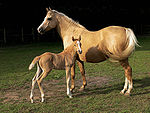
Equestrianism
and sportGlossary of equestrian terms · List of Equestrian Sports · Horse tack · Bit · Bridle · Saddle · Harness · English riding · Western riding · Driving · Horse training · Horse racing · Equestrian at the Summer Olympics (medalists, venues) · Horse show · EquitationEvolution and history Domestication · In warfare · In the Middle Ages · Horses in East Asian warfare · History of the horse in South Asia · Horses in the Napoleonic Wars · Horses in World War I · Horses in World War II · History of the horse in BritainHorse breeds, types
and other EquidaeList of horse breeds · Wild horse · Feral horse · Stock horse · Gaited horse · Draft horse · Warmblood · Sport horse · List of horse breeds in DAD-ISOther EquusHybridsGenera of extinct Equidae (Horse family), arranged by subfamily Kingdom Animalia · Phylum Chordata · Class Mammalia · Infraclass Eutheria · Superorder Laurasiatheria · Order PerissodactylaHyracotheriinae Anchitheriinae Anchitherium · Archaeohippus · Desmatippus · Hypohippus · Kalobatippus · Megahippus · Mesohippus · Miohippus · Parahippus · SinohippusEquinae Merychippus
Tribe Hipparionini: Eurygnathohippus · Hipparion · Hippotherium · Nannippus · Neohipparion · Pseudhipparion
Tribe Equini: Astrohippus · Calippus · Dinohippus · Equus · Hippidion · Onohippidium · Pliohippus · ProtohippusNone Acritohippus · Heteropliohippus · Parapliohippus · ProboscidipparionSpecies of the genus Equus Extinct species are marked †Equus africanus · Equus africanus africanus · Equus africanus asinus · †Equus africanus atlanticus · Equus africanus somaliensis · †Equus complicatus · †Equus conversidens · †Equus crinidens · †Equus cumminsii · †Equus excelsus · Equus ferus · Equus ferus caballus · †Equus ferus ferus · Equus ferus przewalskii · †Equus francisci · †Equus fraternus · †Equus giganteus · Equus grevyi · Equus hemionus · Equus hemionus hemionus · †Equus hemionus hemippus · Equus hemionus khur · Equus hemionus kulan · Equus hemionus luteus · Equus hemionus onager · †Equus hydruntinus · Equus kiang · Equus kiang chu · Equus kiang holdereri · Equus kiang kiang · Equus kiang polyodon · †Equus lambei · †Equus namadicus · †Equus niobrarensis · †Equus occidentalis · †Equus pacificus · †Equus parastylidens · †Equus pectinatus · Equus quagga · Equus quagga burchellii · Equus quagga boehmi · Equus quagga borensis · Equus quagga chapmani · Equus quagga crawshayi · †Equus quagga quagga · †Equus scotti · †Equus simplicidens · †Equus sivalensis · †Equus stenonis · †Equus yunnanensis · Equus zebra · Equus zebra hartmannae · Equus zebra zebraBasic topics in evolutionary biology Processes of evolution Population genetic mechanisms Evolutionary developmental
biology (Evo-devo) conceptsEvolution of organs
and biological processesAging · Avian flight · Cellular · DNA · Eye · Flagella · Hair · Human intelligence · Mammalian auditory ossicles · Mosaic evolution · Multicellular · Nervous Systems · SexTaxa evolution Modes of speciation History of evolutionary thought Charles Darwin · On the Origin of Species · Modern evolutionary synthesis · Gene-centered view of evolution · Life (classification trees)Other subfields Categories:- Cenozoic animals
- Evolution by taxon
- Horse history and evolution
Wikimedia Foundation. 2010.


